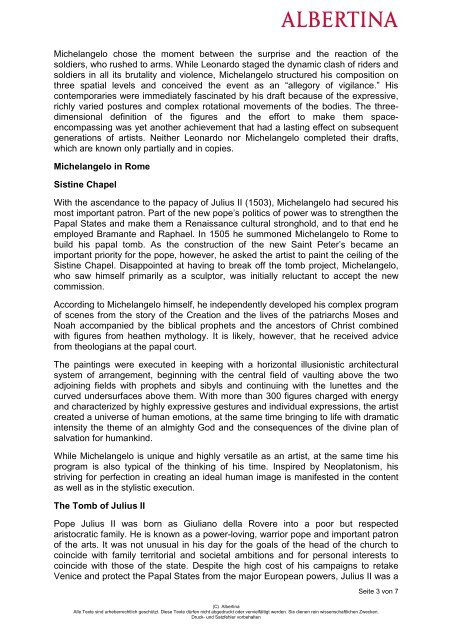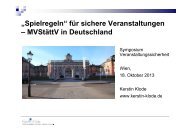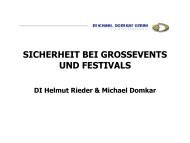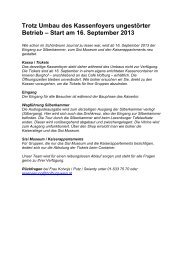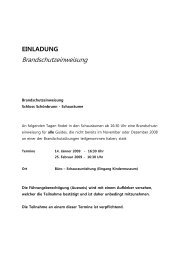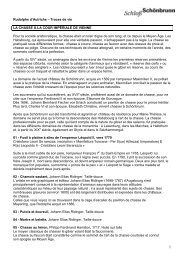Michelangelo. The drawings of a genius - Freizeitbetriebe-wien.at
Michelangelo. The drawings of a genius - Freizeitbetriebe-wien.at
Michelangelo. The drawings of a genius - Freizeitbetriebe-wien.at
Create successful ePaper yourself
Turn your PDF publications into a flip-book with our unique Google optimized e-Paper software.
<strong>Michelangelo</strong> chose the moment between the surprise and the reaction <strong>of</strong> the<br />
soldiers, who rushed to arms. While Leonardo staged the dynamic clash <strong>of</strong> riders and<br />
soldiers in all its brutality and violence, <strong>Michelangelo</strong> structured his composition on<br />
three sp<strong>at</strong>ial levels and conceived the event as an “allegory <strong>of</strong> vigilance.” His<br />
contemporaries were immedi<strong>at</strong>ely fascin<strong>at</strong>ed by his draft because <strong>of</strong> the expressive,<br />
richly varied postures and complex rot<strong>at</strong>ional movements <strong>of</strong> the bodies. <strong>The</strong> threedimensional<br />
definition <strong>of</strong> the figures and the effort to make them spaceencompassing<br />
was yet another achievement th<strong>at</strong> had a lasting effect on subsequent<br />
gener<strong>at</strong>ions <strong>of</strong> artists. Neither Leonardo nor <strong>Michelangelo</strong> completed their drafts,<br />
which are known only partially and in copies.<br />
<strong>Michelangelo</strong> in Rome<br />
Sistine Chapel<br />
With the ascendance to the papacy <strong>of</strong> Julius II (1503), <strong>Michelangelo</strong> had secured his<br />
most important p<strong>at</strong>ron. Part <strong>of</strong> the new pope’s politics <strong>of</strong> power was to strengthen the<br />
Papal St<strong>at</strong>es and make them a Renaissance cultural stronghold, and to th<strong>at</strong> end he<br />
employed Bramante and Raphael. In 1505 he summoned <strong>Michelangelo</strong> to Rome to<br />
build his papal tomb. As the construction <strong>of</strong> the new Saint Peter’s became an<br />
important priority for the pope, however, he asked the artist to paint the ceiling <strong>of</strong> the<br />
Sistine Chapel. Disappointed <strong>at</strong> having to break <strong>of</strong>f the tomb project, <strong>Michelangelo</strong>,<br />
who saw himself primarily as a sculptor, was initially reluctant to accept the new<br />
commission.<br />
According to <strong>Michelangelo</strong> himself, he independently developed his complex program<br />
<strong>of</strong> scenes from the story <strong>of</strong> the Cre<strong>at</strong>ion and the lives <strong>of</strong> the p<strong>at</strong>riarchs Moses and<br />
Noah accompanied by the biblical prophets and the ancestors <strong>of</strong> Christ combined<br />
with figures from he<strong>at</strong>hen mythology. It is likely, however, th<strong>at</strong> he received advice<br />
from theologians <strong>at</strong> the papal court.<br />
<strong>The</strong> paintings were executed in keeping with a horizontal illusionistic architectural<br />
system <strong>of</strong> arrangement, beginning with the central field <strong>of</strong> vaulting above the two<br />
adjoining fields with prophets and sibyls and continuing with the lunettes and the<br />
curved undersurfaces above them. With more than 300 figures charged with energy<br />
and characterized by highly expressive gestures and individual expressions, the artist<br />
cre<strong>at</strong>ed a universe <strong>of</strong> human emotions, <strong>at</strong> the same time bringing to life with dram<strong>at</strong>ic<br />
intensity the theme <strong>of</strong> an almighty God and the consequences <strong>of</strong> the divine plan <strong>of</strong><br />
salv<strong>at</strong>ion for humankind.<br />
While <strong>Michelangelo</strong> is unique and highly vers<strong>at</strong>ile as an artist, <strong>at</strong> the same time his<br />
program is also typical <strong>of</strong> the thinking <strong>of</strong> his time. Inspired by Neopl<strong>at</strong>onism, his<br />
striving for perfection in cre<strong>at</strong>ing an ideal human image is manifested in the content<br />
as well as in the stylistic execution.<br />
<strong>The</strong> Tomb <strong>of</strong> Julius II<br />
Pope Julius II was born as Giuliano della Rovere into a poor but respected<br />
aristocr<strong>at</strong>ic family. He is known as a power-loving, warrior pope and important p<strong>at</strong>ron<br />
<strong>of</strong> the arts. It was not unusual in his day for the goals <strong>of</strong> the head <strong>of</strong> the church to<br />
coincide with family territorial and societal ambitions and for personal interests to<br />
coincide with those <strong>of</strong> the st<strong>at</strong>e. Despite the high cost <strong>of</strong> his campaigns to retake<br />
Venice and protect the Papal St<strong>at</strong>es from the major European powers, Julius II was a<br />
Seite 3 von 7<br />
(C) Albertina<br />
Alle Texte sind urheberrechtlich geschützt. Diese Texte dürfen nicht abgedruckt oder vervielfältigt werden. Sie dienen rein wissenschaftlichen Zwecken.<br />
Druck- und S<strong>at</strong>zfehler vorbehalten


